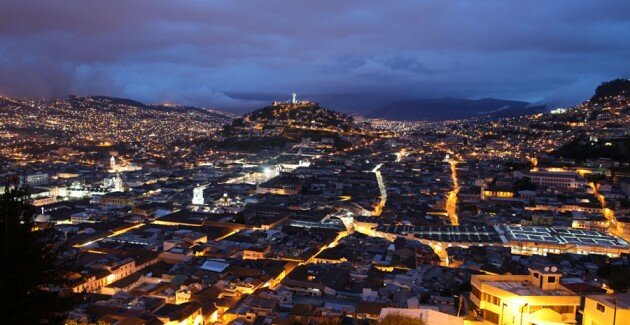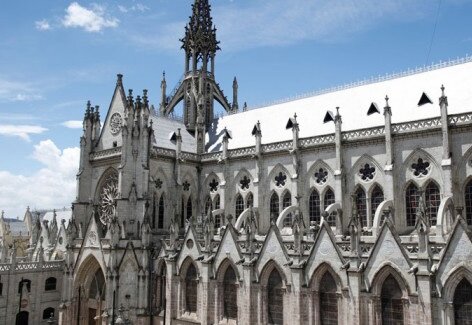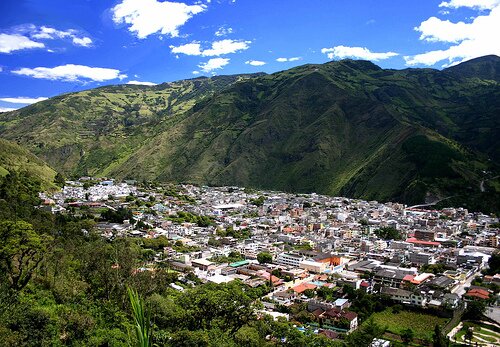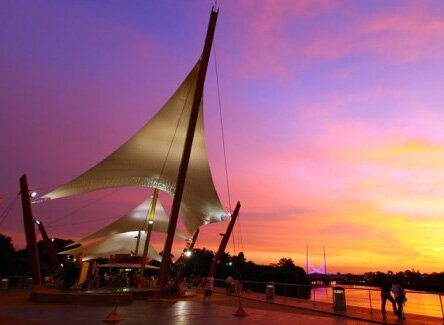
Ecuador may be best known for the famed Galapagos Islands, but its many diverse cities are fun and exciting in their own right. Each city has something to offer -- Quito with its beautifully preserved colonial center and majestic mountain surroundings, Baños with its famous natural hot springs, Guayaquil with its tropical, laid-back vibe, and Otavalo with its world-renowned artisan market. Read on for a brief overview of what some of Ecuador's top cities have to offer. You just might change your plans for your next vacation!
Quito
 The capital of Ecuador is a big, diverse city that boasts a spectacular natural setting. Flanked by majestic Andean mountain peaks, Quito is spread out across a expansive valley at an altitude of about 9,200 feet (2,800 m), making it the second highest capital city in the world. It might take you a few days to get fully used to the thin mountain air as you explore the city's treasures, both old and new. Quito was the first city (along with Krakow, Poland) to be named a UNESCO World Heritage Site in 1978.
The capital of Ecuador is a big, diverse city that boasts a spectacular natural setting. Flanked by majestic Andean mountain peaks, Quito is spread out across a expansive valley at an altitude of about 9,200 feet (2,800 m), making it the second highest capital city in the world. It might take you a few days to get fully used to the thin mountain air as you explore the city's treasures, both old and new. Quito was the first city (along with Krakow, Poland) to be named a UNESCO World Heritage Site in 1978.
The "Old City" district, one of Quito's biggest draws for tourists, is the largest and best-preserved in Latin America. A massive restoration effort completed in 2006 rejuvenated masterpieces of colonial and independence-era architecture, which can be seen in the numerous old churches, historic theatres, town squares, museums, convents, and monasteries that fill this area. Quito's historic district is so vast that you'd need more than one visit to see it all!
To the north, the "modern" district is also a fun place to visit. The Mariscal Sucre neighborhood is especially popular with tourists, as it has many hostels, multi-story hotels, trendy cafés and restaurants, parks, museums, music shows, and nightlife. This is a great place to visit or stay in if you want to be immersed in the young, international backpacker community.
Sustainable accommodations in Quito
Baños
 Known as the "adventure capital" of Ecuador, Baños is situated on a hillside of the active Tungurahua volcano and offers easy access to the Amazon rainforest. Baños is named for its "baths" of sacred water--that is, its hydrothermal springs. People travel from near and far to soak in the natural hot springs and go horseback riding, trekking, mountain biking, climbing, and river rafting. A popular route to take by bike or train is from Baños to Puyo, which offers spectacular views of the upper Amazon Basin.
Known as the "adventure capital" of Ecuador, Baños is situated on a hillside of the active Tungurahua volcano and offers easy access to the Amazon rainforest. Baños is named for its "baths" of sacred water--that is, its hydrothermal springs. People travel from near and far to soak in the natural hot springs and go horseback riding, trekking, mountain biking, climbing, and river rafting. A popular route to take by bike or train is from Baños to Puyo, which offers spectacular views of the upper Amazon Basin.
If you want to tap into the cultural identity of the city, visit the Basílica de Nuestra Señora de Agua Santa (Church of the Virgin of the Holy Waters), a neo-Gothic cathedral that houses a colorful collection of murals depicting local miracles attributed to the Virgin throughout history. Every year in October, the locals celebrate their city's spiritual protector with a street festival filled with music, dancing, food, and drink.
Sustainable accommodations in Baños
Guayaquil

The "Pacific Pearl" of Ecuador is also the country's largest and most populous city. Guayaquil, a port located at the convergence of the Daule and Babahoyo rivers, only very recently begun to attract tourists, giving it a very authentic and unpolished "local" feel. The tropical weather, waterfront, and friendly locals contribute to what some travelers have described as a pseudo-Caribbean vibe.
City residents flock to the Malécon 2000, the modern riverfront area that offers monuments, museums, fountains, shopping malls, restaurants, bars, docks, and scenic viewpoints. At the end of Malécon 2000 is the historic district of Las Peñas, home to quaint and colorful wooden houses, cobblestone streets, and a multitude of small art galleries.
Otavalo
This small city is famous for the culture and talents of its indigenous people, the Otavaleños. They're easily spotted by their traditional attire -- short white pants, dark ponchos, and long braided hair for the men, and intricately embroidered white blouses, long dark skirts, and layers of beaded necklaces for the women. The world-renowned Otavalo market features beautiful traditional handicrafts, jewelry, weaving, street food stalls, herbal and "magical" remedies, fresh produce, and much more. While the bustling market scene is not to be missed, you'll gain a much richer cultural experience by going beyond the market and taking the time to visit the surrounding villages where most of the Otavaleños live. You'll support and perhaps even meet the artisans who handcraft your souvenirs, bypassing the middle-men who sell at the market and often pay their suppliers a mere pittance for their goods.



